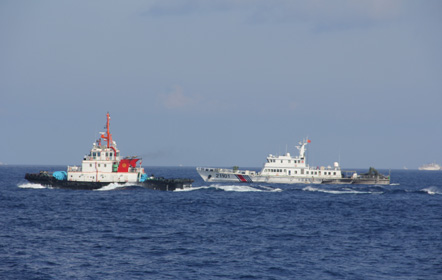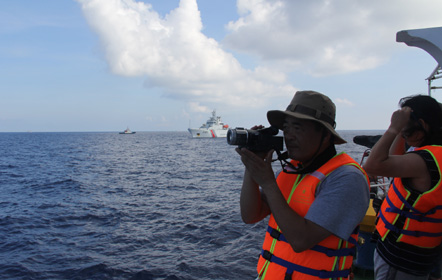
Q: NDN has been in Vietnam for 50 years. Why did its correspondent not participate in the first trip to Hoang Sa, held by the Vietnamese Ministry of Foreign Affairs, but only on the second trip?

Chinese vessels in Vietnam's waters. Photo by Tran Huy Cong.
A: We had registered too late so we had to wait for the second trip. Joining us were correspondents of five other foreign media agencies, including CNN and Viet Weekly (also based in the US), Fuji TV, Yomiuri Shimbun, Ashahi Shimbun, and many Vietnamese reporters.
There were four Japanese media agencies this time, including two television broadcasters and two newspapers, compared with only two television broadcasters on the first trip (Asahi TV and NHK).
Q: How did you feel when you knew that you were admitted to the trip to Hoang Sa?
A: We registered two correspondents, I and a Japanese reporter who filmed the beginning of the Iraq War 11 years ago. As the trip schedule was kept secret, the other correspondent could not wait for over a week so he returned to Japan upon receiving the permission to go on the trip.
I was quite worried because I'm old and have high blood pressure, plus I get seasick. But finally, I was the strongest man among the correspondents on board.
Q: How was the trip?
A: At first, all correspondents were on a ship but when we arrived at the scene, the area near Hoang Sa, where China deploys its HD- 981 oil rig, we were separated on four vessels. The reporter of NDN and those of Yomiuri Shimbun and Viet Weekly were in the 4032, a vessel of the Vietnam law enforcement force.
The other foreign correspondents went to the ship 8003, which is bigger but it did not approach to the Chinese oil rig closely like our vessel, so they had fewer photos of the Chinese ships than correspondents in our ship.
Q: Were you worried when you joined the second trip and could not capture the different scenes from those already filmed by the correspondents of NHK and Asahi TV who participated in the first trip?
A: Yes, I was but I was very lucky. Before the trip, correspondent Duong Dinh Huy of Asahi TV told me that he could not film the scene in which Chinese ships collided with Vietnamese vessels and attacked Vietnamese boats by water cannons.
The female correspondent of NHK was taken to the hospital for an emergency when her ship arrived at the port. According to Tokyo-based NDN, she filmed several Chinese ships in the distance. The pressure on me was huge because NDN waited for my film.
Q: And did you overcome that pressure?
A: After the trip, I had 11 clips, each file is five minutes long. Japanese television channels like NHK, Asahi TV, Tokyo TV, TBS, or NTV wanted to buy the files.
The General Manager of NDN, Misao Ishigaki, called me to say: "This year you have done a very important task, and you can have a holiday from now until the year’s end."
Q: What did you film?

Correspondent Cong.
A: I was on the ship 4032 from May 27 to 31. I filmed two key issues: 1/Ships of the Vietnam Coast Guard and Fishery Surveillance forces performing law enforcement duties; they were prevented by Chinese ships; 2/ the activities of officers and soldiers of the Vietnam Coast Guard.
The law enforcement force of Vietnam consisted of the 4032 vessel of the Coast Guard and three ships of the Fishery Surveillance force. China usually had at least eight ships at the scene. On average, one Vietnamese ship was surrounded by three to four Chinese vessels.
Q: Did the Chinese know about the presence of foreign journalists on Vietnamese ships?
A: When the Vietnamese ships approached the oil rig, the Chinese vessels appeared to block them. Correspondents filmed the scene so the Chinese side knew about our presence and they used tricks.
For example, once Chinese vessels surrounded ships of the Vietnam Fishery Surveillance force. A Vietnamese ship broke down and it could not operate. A Chinese came to cover the Vietnamese ship from our cameras. At the same time another Chinese ship attacked the Vietnamese vessel with water cannons.
For those who have not watched the scene from the beginning, they may think that the Chinese vessel was spraying water toward a Chinese ship in order to watch it but we had filmed it from the start. So the Japanese audience could know clearly that the Chinese ship attacked the Vietnamese vessel with water cannons.
Chinese ships also surrounded Vietnamese boats. Usually four Chinese ships besieged a Vietnamese vessel on the right, the left, the front and the back of the Vietnamese ship.
Chinese ships also ran across the prow of Vietnamese ships in order to collide and film the scene to denounce that Vietnamese ships had rammed Chinese ships.
Q: How far was the ship 4032 from the Chinese oil rig?
A: The 4032 ship approached the oil rig every day but it was always hindered by Chinese vessels. It was about 6.5 to 8 nautical miles from the oil rig.
Do you think that the clips you shot at the scene are enough for the Japanese audience to know about China’s behavior?
It is the right thing that Vietnam allowed international correspondents to go to the field. The most important thing to do at the scene is not to film the acts of attacks of Chinese ship on Vietnamese vessels because upon knowing the presence of foreign correspondents, they would not do such acts.
We went to the scene to verify the information and clips that Vietnam made public at the international press conference on May 8 about the attack of Chinese vessels against Vietnamese ships around the oil rig. If there is a Chinese oil rig and Chinese ships at the reported coordinates, then the images that Vietnam published at the press conference are true.
Q: What about the life of soldiers on the vessels of the Vietnam Coast Guard?
A: Every four days they had a bath because of lack of fresh water. Their meals often lacked vegetables. At about 9-10pm, they caught squid and cooked noodles. They had to keep their noodle bowls by their legs, otherwise noodles would fall out because of big waves.
I filmed a young soldier reading an old newspaper on board. His sad face stood out in the immense scene of water and the velvet sky. I interviewed him and discovered that he is 26 years old, a native from Nam Dinh province. He had not returned home for eight months and he did not know when he would have a chance to visit his family.
Q: The last question: after that trip did the NDN allow you to have long holiday as the general director said?
A: Not, not yet. From May 15, I went to Ly Son Island for 10 days to make a documentary film entitled "Hoang Sa belongs to Vietnam".
Thank you!